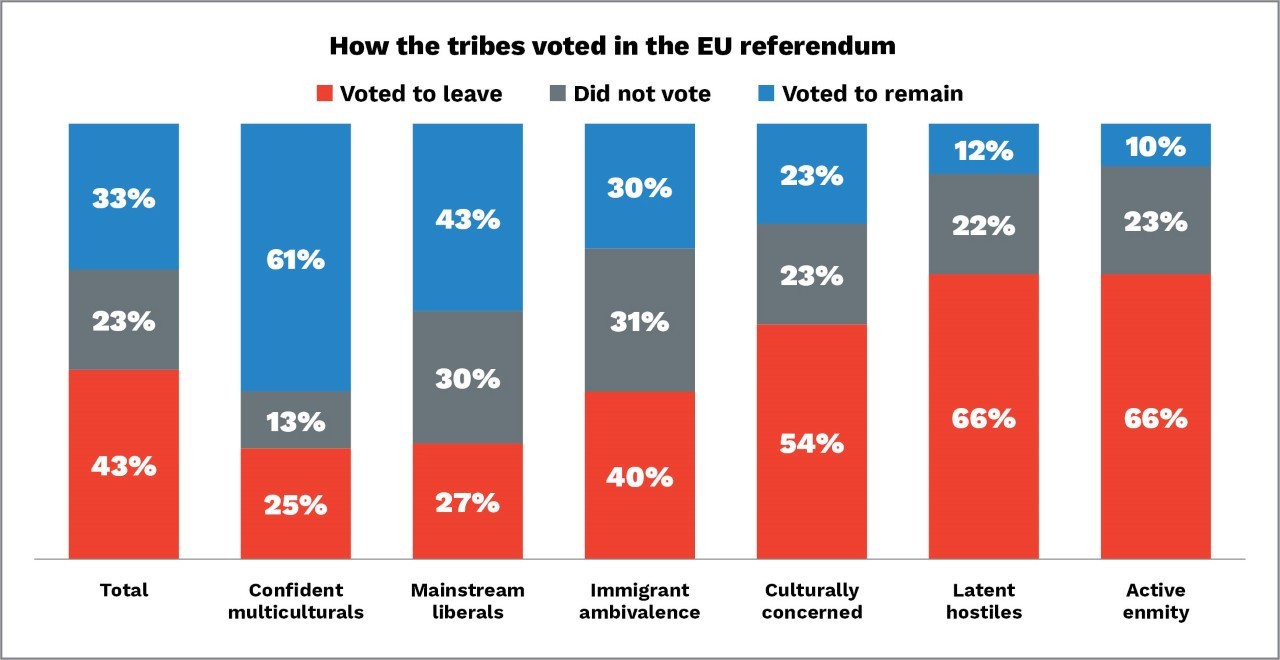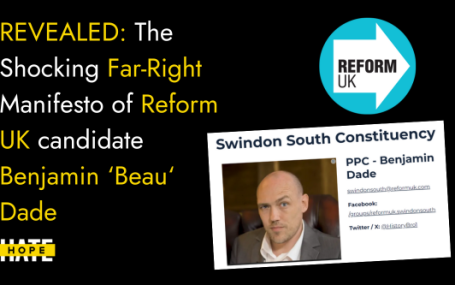HOPE not hate uses cookies to collect information and give you a more personalised experience on our site. You can find more information in our privacy policy. To agree to this, please click accept.
Confident Multiculturals (22% in 2017, 22% in July 2016, 18% in February 2016, 8% in 2011) Most likely to be graduates or post graduates, these…

Confident Multiculturals
(22% in 2017, 22% in July 2016, 18% in February 2016, 8% in 2011)
Most likely to be graduates or post graduates, these people are predominantly professionals and managers. They are more prevalent in London and the South East, and among people who identify with Labour, Liberal Democrat and Green. Outgoing, social and happy with their lives, they are confident about their own, as well as their country’s future, and think Britain has benefitted from immigration.
The smallest group in 2011, confident multiculturals are now the largest segment, making up 22% of the population. The group more than doubled in size between 2011 and February 2016 as economic recovery offered a greater sense of security and confidence, and saw further growth following the EU referendum. This group were most likely to vote to remain in the EU (61%).
Mainstream Liberals
(17% in 2017, 16% in July 2016, 14% in February 2016, 16% in 2011)
These people are optimistic, self-motivated and for the most part educated to at least degree level. They see immigration as a net benefit to the country, and usually differ from confident multiculturals only in their level of enthusiasm about it. More likely to have voted remain in the referendum (43%), this group has remained roughly the same size since 2011.
Identity Ambivalents
(21% in 2017, 26% in July 2016, 20% in February 2016, 28% in 2011)
These people are less financially secure and less optimistic about the future. They are more likely to be working class, to live in social housing and to view immigration through the prism of its economic impact on their opportunities and the social impact on their communities.
Muslims and other BME (Black and Minority Ethnic) groups are more prevalent here and most identifying with the tribe are of working age, between 25-44. This tribe are more likely to have voted leave in the EU referendum (40%) but also host the greatest share of those who did not vote in the referendum (31%).
Since 2011 the proportion of those in the identity ambivalents tribe has decreased to around the same levels as in February 2016, as economic recovery after the 2008 crash has eased concerns held by this economically sensitive group.
There was a spike in the proportion of people in this category directly after the EU referendum, which may be reflective of the focus on economic arguments tied to immigration throughout the referendum campaigns, although this change appears to have subsided over the last year.
Culturally Concerned
(18% in 2017, 16% in July 2016, 24% in February 2016, 24% in 2011)
Generally older – 27% of the over-65s identify with this tribe. Many are (or have been) professionals and managers but the social class make up of this group has changed since 2011 to include a greater proportion from C2DE classes.
They are more likely to view immigration as a cultural issue, with concerns about the impact of immigration on national identity and about immigrants’ willingness to integrate. This group forms the largest segment of those identifying with the Conservative Party and are most likely to have voted leave in the 2016 referendum (54%).
The culturally concerned group held a constant share of the population between 2011 and February 2016, but saw a decrease of 8% just after the referendum.
Latent Hostiles
(17% in 2017, 13% in July 2016, 16% in February 2016, 10% in 2011)
More likely to be over-35, not university-educated, and more than likely working class. They view their own future with uncertainty and Britain’s future with pessimism.
For them, immigration has undermined British culture, public services and their own economic prospects. They would support political forces that stood up for their identity and way of life, but are less confrontational than those in active enmity segment. This group were most likely to vote leave in the EU referendum and are more likely to be economically pessimistic and fear the impacts of immigration on British culture.
The latent hostile group has increased from 10% in 2011 to 17% in 2017, as the active enmity tribe has shrunk. This would indicate that there remains a persistent section of the population aligned with a hostile set of identity politics – however they have become less hard-line over time.
This group is most likely to identify with UKIP.
Active Enmity
(5% in 2017, 7% in July 2016, 8% in February 2016, 13% in 2011)
Drawing more support from the unskilled and the unemployed, these people are the most disengaged from traditional political processes and the most hostile to immigrants and what they think immigration represents. They were most likely to vote leave in the EU referendum,
Opposed to all ethnicities or religions other than their own, many believe that violence is acceptable if it is a consequence of standing up for what is ‘right’.
This group has declined sharply since 2011, now making up just 5% of the population. This encouraging development indicates that even those with the deepest concerns about identity and immigration are now more likely to engage with the political system, and less likely to consider direct action or violence as a means to express their concerns.

A Reform Party candidate fantasised about deporting “millions” of British citizens to “rid itself of the foreign plague we have been diseased with”. UPDATE: Reform…